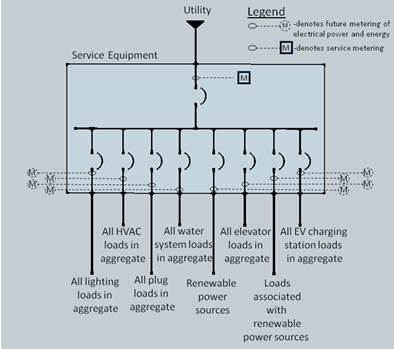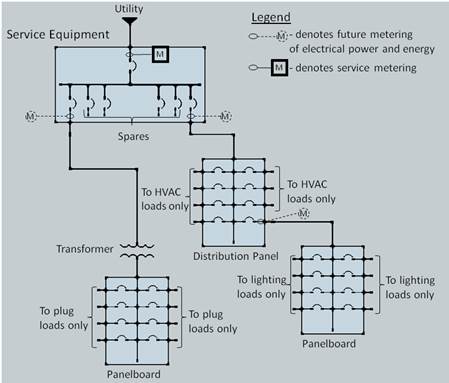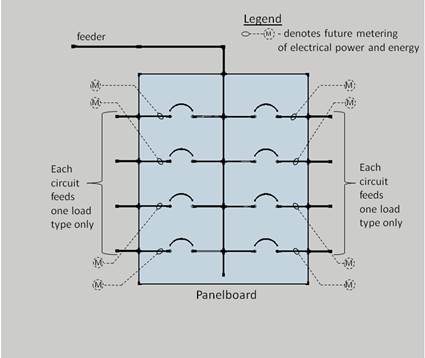The
separation of electrical circuits requirement allows monitoring the specific
contributions of separate loads to the overall energy use of a building. By
designing the electrical distribution system with separation of electrical loads
in mind, energy monitoring can be readily set up and implemented without
significant physical changes to the electrical installations. The goal is to be
able to monitor the electrical energy usage of each load type specified in Table
130.5-B of the Energy Code. Building owners, facility management, and
others can make use of such energy usage information to better understand how
much energy has been used by each building system during a certain period.
Further analysis of such energy information can help facilitate energy
efficiency and related measures to improve building energy performance for
building owners and operators.
Table
130.5-B specifies the load types that must be separated. These requirements
vary depending on the kVA rating of the electrical service.
Healthcare facilities are
exempt from the separation of electrical circuits requirement.
Example 8-6: Separation of Electrical Loads – Service
Rated Less Than 50 kVA
Question:
My
new nonresidential building is served by a single panel with a
service less than 50 kVA.
What
is the required separation of electrical circuits for this building?
Answer:
Renewable power sources and electric vehicle charging
stations must be separated from other electrical load types and from each other,
in accordance with the “Electrical Service rated 50kVA or less” column of
Table
130.5-B and §130.5(b). The renewable power sources must be separated by
group. All electric charging vehicle loads can be in aggregate.
If there are no renewable power sources or electric
vehicle charging stations in this building, it is not required to separate the
electrical circuits for electrical energy monitoring.
Electrical
power distribution systems must be designed so that measurement devices can
monitor the electrical energy usage of load types according to Table
130.5-B. However, for each separate load type, up to 10 percent of the
connected load may be of another load type. The Energy Code allows any approach
that provides the ability to measure the loads of the building separately.
The separation of
electrical circuits requirement of §130.5(b) may be satisfied by
any method that accomplishes this goal, including any of the following example
methods:
A.
Example Method 1 (See Example 8-7)
Switchboards, motor
control centers, or panelboards may be separated by load type, allowing energy
measurement of each load type independently and readily. This method must allow
measurement and determination of the actual interval demand load value for each
disaggregated load in the system.
This is
a straightforward approach for measurement of each load type, as each
switchboard, motor control center, or panelboard serves a single load type.
Summation of the load measurement of the distribution equipment in accordance with the
respective load type can result in the energy usage of each load type. This
method is simple and straightforward in terms of the effort required in
compiling the measurement data.
B.
Example Method 2 (See Example 8-8)
Switchboards, motor
control centers, or panelboards may supply other distribution equipment with the
associated loads separated for each load type. The measured load for each piece
of distribution equipment must be able to be added or subtracted from other
distribution equipment supplying them. This method must allow measurement for
each disaggregated load in the system.
This
method allows distribution equipment to serve more than one load type while
allowing the separate energy use of each load to be determined. More effort may
be required in obtaining the energy usage of each load type.
C.
Example Method 3 (See Example 8-9)
Switchboards, motor
control centers, or panelboards may supply more than one load type as long as
each branch circuit serves a single load type, and the equipment includes
provisions for measuring individual branch circuits. For example, neighboring
branch circuits in a panelboard may serve receptacles and fans, respectively,
but the branch circuits cannot serve mixed load types.
D. Example
Method 4
Buildings for which a
complete metering and measurement system is provided so each load type can be
measured separately.
This
method allows a complete metering system to be used to meet the requirements of
§130.5(b),
provided that, at a minimum, the system measures and reports the loads called
for in Table
130.5-B of the Energy Code. Such an installation goes beyond the requirement
of the Energy Code as it meters and measures the power and energy usage of each
load type. It provides benefits for building owners and operators by giving them
a readily available tool for assessing the building energy usage as soon as the
facility is turned over to them.
Example 8-7: Separation of Electrical Circuits by
Panelboard
Question:
I
am working on a new nonresidential building project with a service more than 50 kVA and less than
250 kVA. Following is the proposed separation of circuits for connecting
different load types to the service equipment. Does this
concept meet the requirements of the Energy Code?

Answer:
The
proposed design meets the separation of electrical circuit requirement of
§130.5(b) as there are separations of circuits for connecting
different load types to the service equipment. There should be provisions
including physical spaces for future setup of measurement devices for energy
monitoring at each electrical installation location.
Example 8-8: Separation of Electrical Circuits by
Panelboards and Subpanels
Question:
Part
of my proposed design is to use a distribution panel serving HVAC loads, with
the panel also feeding a lighting subpanel. There is a separate panelboard serving plug
loads only.
Does
this design meet the requirements of the Energy Code?

Answer:
The
proposed design meets the separation of electrical circuit requirement of
§130.5(b) as each load type in the building can be accounted for
by addition and
subtraction of the measured loads, as indicated in Method 2.
Example 8-9: Separation of Electrical Circuits by Branch
Circuits
Question:
Can
a panelboard with provisions allowing branch circuit energy monitoring be used
to meet the separation of electrical circuits requirement? Each circuit would
serve no more than one load type.

Answer:
The proposed design allows each load type to be
separately measured at the branch circuit, so it meets the requirements of
§130.5(b).
The
Energy Code allows the use of conventional panelboards, motor control centers,
and other standard wiring methods for meeting the separation requirement. The
requirement may also be met by a well-planned wiring approach, such as
connecting all HVAC units to a single feeder from the service using a combination of through
feeds and taps. The regulations are intentionally written to specify the “what”
without prescribing the “how,” providing flexibility.
In a
“typical” small building with a service size of 50 kVA or less, separation of
electrical loads is not required for the building loads, except for any
renewable power sources (solar PV systems) and electric vehicle charging
stations installed at the building.
In
buildings with a service size between 50 kVA and 250 kVA, separate risers for lighting,
receptacles/equipment, and HVAC are allowed to be used for meeting the
separation of electrical circuits requirement. Large loads or groups of loads,
such as an elevator machine room or a commercial kitchen, may be connected to
panelboards or motor control centers served by a dedicated feeder, and the
electrical power and energy of the entire group of loads can be measured by
metering the feeder.
For
buildings with a service size more than 250 kVA, lighting and plug loads are
required to be separated by floor, type, or area. In a single-story building,
all the lighting loads could be fed from a single panel, and all the plug loads
could be fed from another panel (or, alternatively, both types of loads could be
fed from one panel with provision to allow for future metering for each load
type – metering data further be further organized, compiled, and viewed with
software or mobile applications for each load type).
In a
multistory building, a simple way to comply would be to install a separate
lighting panel and a separate plug-load panel for each floor of the building.
However, it would also be acceptable (and may be more useful) to divide the load
according to which area of the building it serves (such as office, warehouse, and
corridors) or by the type of light fixture (for example, metal-halide, fluorescent,
dimmable, and fixed-output). For example, the first- and second-floor office
lights could be fed from the same panel, while the warehouse lights are fed from
a second panel. Dividing the load by area or type instead of by floor is more
likely to yield useful information when the loads are analyzed in an energy
audit. All the above approaches are acceptable methods of complying with the
Energy Code.


